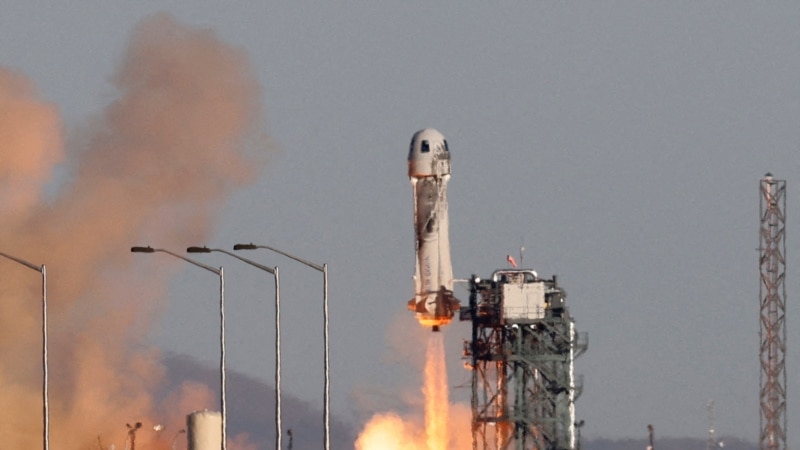
Blue Origin launched its first rocket in more than a year on Tuesday, reviving the U.S. company’s fortunes with a successful return to space following an uncrewed crash in 2022.
Though mission NS-24 carried a payload of science experiments, not people, it paves the way for Jeff Bezos’ aerospace enterprise to resume taking wealthy thrill-seekers to the final frontier.
The New Shepard suborbital rocket blasted off from the pad at Launch Site One, near Van Horn, Texas, at 10:42 a.m.
After separating from the booster, the gumdrop-shaped capsule attained a peak altitude of 107 kilometers above sea level, well above the internationally recognized boundary of space known as the Karman line, which is 100 kilometers high.
The booster then successfully landed vertically on the launchpad, against the majestic backdrop of the Sierra Diablo mountains, followed a few minutes later by the capsule floating to the desert floor on three giant parachutes.
All in all, the mission lasted 10 minutes and 13 seconds.
“Demand for New Shepard flights continues to grow, and we’re looking forward to increasing our flight cadence in 2024,” said Phil Joyce, the company’s senior vice president.
The science experiments onboard included one to demonstrate the operation of hydrogen fuel cell technology in microgravity, and another showing how water and gas move in a weightless environment.
Future applications could include monitoring water quality for astronauts in space.
On Sept. 12, 2022, a Blue Origin rocket became engulfed in flames shortly after launch. The capsule, fixed to the top of the rocket, successfully initiated an emergency separation sequence and floated safely to the ground on parachutes.
The accident prompted a year-long probe by the Federal Aviation Administration, which found it was caused by the failure of an engine nozzle that experienced higher-than-expected operating temperatures.
The regulator issued a set of corrective actions for Blue Origin to undertake before it could resume flying, including the redesign of certain engine parts. It confirmed Sunday that it had approved Blue Origin’s application to fly again.
In all, Blue Origin has carried out six crewed flights — some passengers were paying customers and others were guests — since July 2021, when Bezos himself took part in the first.
While Blue Origin has been grounded, rival Virgin Galactic — the company founded by British billionaire Richard Branson — has pressed on, with five commercial flights this year.
While Blue Origin launches a small rocket vertically, Virgin Galactic uses a large carrier plane to gain altitude and then drop off a smaller, rocket-powered spaceplane that completes the journey to space.
In both cases, passengers enjoy a few minutes of weightlessness and can view the curvature of the Earth through large windows.
Virgin Galactic tickets were sold for between $200,000 to $450,000; Blue Origin does not publicly disclose its ticket prices.
Blue Origin can boast the fact that nearly all of its rocket platform is reused, including the booster, capsule, engine, landing gear and parachutes.
Blue Origin is also developing a heavy rocket for commercial purposes called New Glenn, with the maiden flight planned for next year.
This rocket, which measures 98 meters high, is designed to carry payloads of as much as 45 metric tons into low Earth orbit.

Blue Origin launched its first rocket in more than a year on Tuesday, reviving the U.S. company’s fortunes with a successful return to space following an uncrewed crash in 2022.
Though mission NS-24 carried a payload of science experiments, not people, it paves the way for Jeff Bezos’ aerospace enterprise to resume taking wealthy thrill-seekers to the final frontier.
The New Shepard suborbital rocket blasted off from the pad at Launch Site One, near Van Horn, Texas, at 10:42 a.m.
After separating from the booster, the gumdrop-shaped capsule attained a peak altitude of 107 kilometers above sea level, well above the internationally recognized boundary of space known as the Karman line, which is 100 kilometers high.
The booster then successfully landed vertically on the launchpad, against the majestic backdrop of the Sierra Diablo mountains, followed a few minutes later by the capsule floating to the desert floor on three giant parachutes.
All in all, the mission lasted 10 minutes and 13 seconds.
“Demand for New Shepard flights continues to grow, and we’re looking forward to increasing our flight cadence in 2024,” said Phil Joyce, the company’s senior vice president.
The science experiments onboard included one to demonstrate the operation of hydrogen fuel cell technology in microgravity, and another showing how water and gas move in a weightless environment.
Future applications could include monitoring water quality for astronauts in space.
On Sept. 12, 2022, a Blue Origin rocket became engulfed in flames shortly after launch. The capsule, fixed to the top of the rocket, successfully initiated an emergency separation sequence and floated safely to the ground on parachutes.
The accident prompted a year-long probe by the Federal Aviation Administration, which found it was caused by the failure of an engine nozzle that experienced higher-than-expected operating temperatures.
The regulator issued a set of corrective actions for Blue Origin to undertake before it could resume flying, including the redesign of certain engine parts. It confirmed Sunday that it had approved Blue Origin’s application to fly again.
In all, Blue Origin has carried out six crewed flights — some passengers were paying customers and others were guests — since July 2021, when Bezos himself took part in the first.
While Blue Origin has been grounded, rival Virgin Galactic — the company founded by British billionaire Richard Branson — has pressed on, with five commercial flights this year.
While Blue Origin launches a small rocket vertically, Virgin Galactic uses a large carrier plane to gain altitude and then drop off a smaller, rocket-powered spaceplane that completes the journey to space.
In both cases, passengers enjoy a few minutes of weightlessness and can view the curvature of the Earth through large windows.
Virgin Galactic tickets were sold for between $200,000 to $450,000; Blue Origin does not publicly disclose its ticket prices.
Blue Origin can boast the fact that nearly all of its rocket platform is reused, including the booster, capsule, engine, landing gear and parachutes.
Blue Origin is also developing a heavy rocket for commercial purposes called New Glenn, with the maiden flight planned for next year.
This rocket, which measures 98 meters high, is designed to carry payloads of as much as 45 metric tons into low Earth orbit.
Blue Origin, the aerospace company founded by Jeff Bezos, successfully launched its first rocket in over a year, marking a comeback after an uncrewed crash in 2022. The mission, named NS-24, carried science experiments but not people, signaling the company’s readiness to resume taking wealthy individuals to space. The New Shepard suborbital rocket took off from Launch Site One in Texas and reached an altitude of 107 kilometers, surpassing the internationally recognized boundary of space. The booster and capsule both returned safely to the launchpad and desert floor, respectively, marking a 10-minute and 13-second mission. Blue Origin plans to increase its flight cadence in 2024 due to growing demand.
The science experiments conducted on the mission included testing hydrogen fuel cell technology in microgravity and observing the movement of water and gas in a weightless environment. These experiments could have future applications in areas such as monitoring water quality for astronauts in space. Blue Origin had faced a year-long grounding due to an accident in 2022, which was caused by the failure of an engine nozzle. The Federal Aviation Administration conducted an investigation and issued corrective actions for the company, including the redesign of certain engine parts. Blue Origin’s application to fly again was recently approved by the regulator.
Blue Origin’s competitor, Virgin Galactic, continued its commercial flights during Blue Origin’s hiatus. Virgin Galactic uses a carrier plane to reach altitude and then releases a smaller, rocket-powered spaceplane for the journey to space. Both Blue Origin and Virgin Galactic offer passengers a few minutes of weightlessness and the opportunity to view the Earth’s curvature through large windows. While Virgin Galactic publicly disclosed ticket prices ranging from $200,000 to $450,000, Blue Origin’s ticket prices remain undisclosed.
An interesting aspect of Blue Origin’s rockets is their reusability, with nearly all components, including the booster, capsule, engine, landing gear, and parachutes, being reused. Blue Origin is also developing a heavy rocket called New Glenn for commercial purposes, with its maiden flight planned for next year. This rocket is designed to carry payloads of up to 45 metric tons into low Earth orbit.
In current context, Blue Origin’s successful return to space marks a significant milestone for the company. It demonstrates their ability to overcome setbacks and resume their operations in the competitive space tourism industry. As the demand for space travel continues to grow, Blue Origin’s revival and plans for increased flight frequency in the future indicate their commitment to meeting the needs of customers seeking unique and awe-inspiring experiences beyond Earth.



